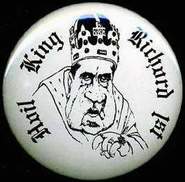![]()
Rhetoric of President Richard M. Nixon
SELECTED
BIBLIOGRAPHY
Allan Louden, Wake Forest University (louden@wfu.edu)
3Last Updated: Thursday, 29-Jan-2015 14:32:42 EST

Asen, R. (2001). Nixon's welfare reform: Enacting historical contradictions of poverty discourses, Rhetoric & Public Affairs, 4, 261-279.
Benoit, W. L. (1982). Richard M. Nixon's rhetorical strategies in his public statements on watergate. Southern Speech Communication Journal, 47, 192-211.
Black, E. (1996). The invention of Nixon. In M. J. Medhurst (Ed.), Beyond the rhetorical presidency (pp. 104-121). College Station, TX: Texas A&M University Press.
Bochin, H. W. (1990). Richard Nixon: Rhetorical strategist. Westport, CT: Greenwood Press, Great American Orators.
Bostdorff, D. M. (2002). The evolution of a diplomatic surprise: Richard M. Nixon's rhetoric on China, 1952-July 15, 1971. Rhetoric and Public Affairs, 5, 31-56.
Carpenter, R. H., & Seltzer, R. W. (1974). Nixon, Patton, and the Silent Majority sentiment about the view Nam War: The cinematographic bases of a rhetorical stance. Central States Speech Journal, 25, 105-110.
Carpenter, R. H. and Seltzer, R. V. (1970). On Nixon's Kennedy style. Speaker and Gavel, 41-43.
Depoe, S. P. (1991). Space and the 1960 presidential campaign: Kennedy, Nixon, and "public time." Western Journal of Communication, 55, 215-233.
Greenberg, D. (2003, Dec.). Nixon's Image Maker. New York Times Magazine, 153, 38-.
Hillbruner, A. (1974). Archetype an signature: Nixon and the 1973 inaugural. Central States Speech Journal, 25, 169-181.
Jacobs, L. R., Page, B. I., Burns, M. McAvoy, G. & Oster, E. (2003). What presidents talk about: The Nixon case. Presidential Studies Quarterly; 33, 751-771.
Klumpp, J. F.& Lukehart, J. K. (1978). The pardoning of Richard Nixon: A failure in motivational strategy. Western Journal of Speech Communication, 42, 116-123.
Lee, R. (1988). Moralizing and ideologizing: An analysis of political illocutions. Western Journal of Speech Communication, 52, 291-307.
Lee, R. (1989). The featuring of will in history: A rhetorical exploration of Richard Nixon's post-presidential writings. Quarterly Journal of Speech, 75, 453-466.
Llewellyn, J. (2010).Paws, Pathos and Presidential Persuasion: Franklin Roosevelt’s “Fala Speech” as Precursor and Model for Richard Nixon’s “Checkers Speech”. Communication and Theatre Association of Minnesota Journal, 37, 64-76.
Minielli, M. & Hazen, M. D. (2013). Richard M. Nixon’s Cold War rhetoric, crisis definitions, and the hidden motive of the 1972 Presidential election. Topical Issues of Communication and Culture, 13, 58-77.
Mullen, J. J. (1963). Newspaper advertising in the Kennedy-Nixon campaign, Journalism Quarterly, 40, 3-11.
Peretz, P. (2014). President Nixon's broken promise to “Bring the American People Together”. Presidential Studies Quarterly, 44, 673–696.
Rasmussen, K. (1973). Nixon and the strategy of avoidance. Central States Speech Journal, 24, 193-202.
Renz, M. A. (1987). The cabinet member as a representative of the president: The case of James Watt. Central States Speech Journal, 38, 94-110.
Rosenfeld, L. W. (1968). A case study of speech criticism: The Nixon-Turman analog. Speech Monographs, 35, 435-450.
Sigelman, L. (2002). The presentation of self in presidential life: Onstage and backstage with Johnson and Nixon. Political Communication, 18. 1–22.
Vartabedian, R. A. (1985). Nixon's Vietnam rhetoric: A cast study of apologia as generic paradox. Southern Speech Communication Journal, 50, 366-381.